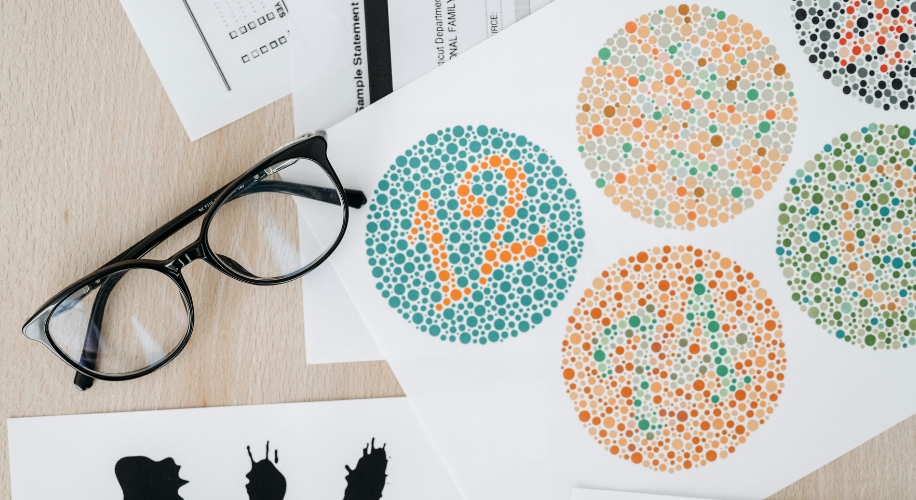Understanding Color Blindness: A Comprehensive Guide
Color blindness is a condition that affects millions of people worldwide. While often misunderstood, it goes beyond just seeing the world in black and white. In this blog, we’ll delve into the various types of color blindness, its causes, its effects on daily life, and potential solutions.
Photo by Pavel Danilyuk
What is Color Blindness?
Color blindness, or color vision deficiency, is the inability to perceive colors in the usual way. Most commonly, it affects the ability to distinguish between certain colors, particularly reds and greens, or blues and yellows. Contrary to popular belief, true color blindness, where one sees no colors at all, is rare.
Types of Color Blindness
There are several types of color blindness, each characterized by different challenges in color perception:
1. Red-Green Color Blindness
This is the most common form, affecting about 99% of those with color blindness. It is further divided into two categories:
- Protanopia: Inability to perceive red light.
- Deuteranopia: Inability to perceive green light.
Both types can make it difficult to differentiate between reds, greens, and browns.
2. Blue-Yellow Color Blindness
Less common than red-green color blindness, this type includes:
- Tritanopia: Difficulty in distinguishing between blue and yellow, leading to confusion in shades and hues.
3. Monochromacy
Also known as total color blindness, individuals with this condition can only see in shades of gray. This is extremely rare and often accompanied by other visual impairments.
Photo by Jan Kroon
Causes of Color Blindness
Color blindness is primarily genetic, caused by mutations in the genes responsible for the pigments in the eye’s cone cells. The most common type, red-green color blindness, is linked to the X chromosome, making it more prevalent in males.
Other causes include:
- Aging: The aging process can affect color perception.
- Eye diseases: Conditions like cataracts and glaucoma can impact color vision.
- Medications: Certain medications may alter color perception as a side effect.
Diagnosing Color Blindness
Diagnosing color blindness typically involves a series of tests.
- Ishihara Test: Contains a series of colored plates with numbers or patterns that are difficult to see for those with color vision deficiencies.
- Farnsworth-Munsell 100 Hue Test: Assesses the ability to discern subtle differences in color.
- Anomaloscope: A more specialized test that helps determine the type and severity of color blindness.
Photo by Pavel Danilyuk
Impact on Daily Life
Color blindness can affect various aspects of daily life, from choosing clothing to navigating the world. Here are some common challenges faced by individuals with color blindness:
- Education: In educational settings, color-coded materials can pose challenges. Charts, maps, and graphs often rely on color to convey information, making it difficult for color-blind students to engage fully.
- Employment: Certain professions, particularly those in design, art, or fields where color differentiation is crucial, may be challenging for color-blind individuals. However, many adapt and excel in careers that don’t rely heavily on color perception.
- Driving: Traffic lights and road signs can sometimes be challenging for those with color blindness. Although many can learn to recognize the position of lights, some may struggle with color-coded signals.
- Social Interactions: Social situations, such as fashion or home decor, can also be complicated. Friends and family might not understand the challenges of color blindness, leading to frustration in social settings.
Photo by Kelly
Strategies and Solutions
While there is no cure for color blindness, there are several strategies and tools available to help individuals cope:
- Color-Corrective Lenses: These tinted glasses can enhance color discrimination for some individuals. They work by filtering out specific wavelengths of light, allowing the wearer to see colors more distinctly. However, results can vary from person to person.
- Apps and Technology: Various mobile apps and software programs can assist with color identification. These tools can be particularly useful in everyday situations, such as shopping or choosing clothes.
- Educational Accommodations: Schools and workplaces can provide accommodations, such as using patterns in addition to color, to help those with color blindness access information more easily.
- Support and Awareness: Raising awareness about color blindness can help foster understanding and support. By educating friends, family, and colleagues, individuals with color blindness can navigate social situations more comfortably.
Photo by Porapak Apichodilok
Living with Color Blindness
Color blindness is a fascinating condition that presents both challenges and opportunities for those who experience it. As awareness grows, so too does our ability to support those who see the world a little differently. Whether through technology, education, or simply understanding, there are many ways to make the world more accessible for everyone, regardless of their color perception.









 Canada
Canada